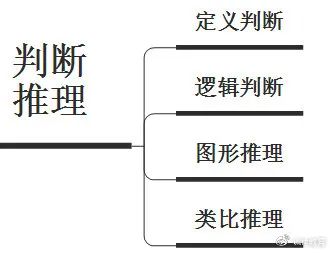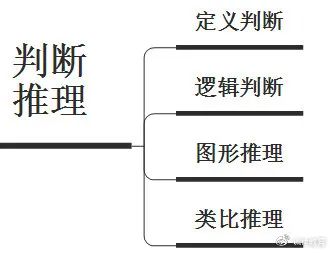1. What Does Judgment Reasoning Test?
The judgment reasoning section of the examination includes two main categories: Judgment and Reasoning. Judgment includes Definition Judgment and Logical Judgment; Reasoning includes Graphic Reasoning and Analogy Reasoning.

Judgment: This is a form of thought that makes determinations about objects of thought, where propositions express judgments. The outcome is whether the proposition or statement is true or false, real or fake. Since judgments are about truth and falsehood, they must be based on evidence. To judge whether “Zhang San is a university student,” we need to understand the connotation and denotation of the concept of a university student. To achieve results in formal logical judgments, one must be familiar with the rules of formal logic reasoning in advance. Therefore, the method for tackling definition judgment questions lies in the definitions provided in the question stem, while the skill for logical judgment questions involves understanding the relevant knowledge from “General Logic.”
Reasoning: This is a form of thought that derives a new judgment from one or several known judgments. The reasoning process requires rigor; the more rigorous and comprehensive the reasoning, the more reliable it is. Thus, graphic reasoning and analogy reasoning both rely on the known information in the question stem to deduce and select the optimal option.
2. Score Proportion of Judgment Reasoning.
In the National Civil Service Examination (referred to as “National Exam”): There are 40 questions, accounting for 29.63%, with 10 questions in each of the four types, averaging 0.7 points per question.
Multi-Province Joint Examination: There are 35 questions, accounting for 29.17%, with the number of questions in each type not fixed, but at least 5 questions per type. Averaging 0.85 points per question.
Sichuan Provincial Examination: Since the second half of 2014, the number of questions in the examination paper has been adjusted to 100, with each question worth 1 point. Judgment reasoning has either 30 or 35 questions, with 30 questions being the most common, totaling 30 points. The specific number of questions is as follows:

3. Learning Objectives for Judgment Reasoning.
Control the accuracy rate at 75%, with some experts stabilizing at 85%, which means keeping the number of incorrect answers to within 5. In the past, during class, a student sincerely asked me, “Teacher Li, why can’t I get all the judgment reasoning questions right? I always miss one or two.” The examiners also want to maintain their credibility, right? Most of the time, candidates should not expect to get everything right; there will always be knowledge blind spots. At the very least, if an analogy reasoning question presents common knowledge, we might just be stumped. For example:
Balloon Flower is to ( ) as ( ) is to Olive Branch
A. Rose / Lotus
B. Arena / Peace
C. Carnation / Dove
D. Mimosa / Evergreen
The answer to this question is A.
Thus, our pursuit in the examination is a controllable accuracy rate, not getting every question right.
4. How to Study Judgment Reasoning.
The knowledge points and systems for the four types of judgment reasoning questions are distinct and can be tackled one by one. Among them, logical judgment, due to its knowledge system originating from “Logic,” is sometimes taught using logic textbooks as a foundation, explaining the entire logical system. I personally believe this is unnecessary. First, not all content in the logic book is tested; second, logic itself is often abstract and difficult to understand. It is better to start with the questions and learn quick solving techniques. Those interested in the underlying logical system can study it further.
Learning judgment reasoning can be divided into three steps. The first is theoretical learning, the second is practice through solving questions, and the third is mock exam practice.
The first step, theoretical learning. Whether through online courses, books, or self-study, the final measure is whether candidates have established their own mind maps. Writing a mind map is crucial; on one hand, it consolidates key points, and on the other, it helps deduce the patterns of the questions. It is best to write it out on blank paper after finishing the theory, rather than directly copying the notes of the teacher or other students. This process of creating from scratch not only organizes key points but also builds our confidence.

In this part, Chengshi Education has developed a step-by-step online course for the “Examination + Essay” preparation, progressively deepening from basic theoretical explanations to practical solving techniques. Science runs through the entire preparation process; for more information, please click: Sichuan Provincial Civil Service Examination “Examination” and “Essay” Full Course.
The second step is practice through solving questions. Actions speak louder than words. Some students overthink before practicing questions, wondering if solving questions is useful, if it is effective, if they are doing useless work, and if the question sea tactic is scientific, etc. The exam is fundamentally assessed through questions, so necessary practice is essential for consolidating key points, mastering question trends, and correcting faulty thought processes.
The necessary volume of practice questions for judgment reasoning is at least 600. You can start by categorizing the types, such as 100 analogy reasoning questions, 200 graphic reasoning questions, etc., and organize your own schedule.
During the practice, it is important to think critically, summarize, and review your mind map. Stop every day, every two days, or every 50 questions to review your mind map, making appropriate additions and deletions. The rhythm is: mind map → practice questions → review mind map → practice questions.
In this regard, Chengshi Education has produced a civil service examination question bank of 10,000 questions (physical copy shipped), based on past exam questions, scientifically selecting 10,000 questions, organized by modules, knowledge points, and levels, allowing candidates to practice with more direction, deepening techniques and breaking through knowledge points one by one. To purchase, please click: Civil Service Examination 10,000 Question Bank
Appendix: High Score Student Experience Sharing.
The third step is mock exam practice. Use real exam papers for timed, simulated exams, strictly controlling the time and order of answering questions. The recommended order for the four types of questions is: Definition Judgment → Analogy Reasoning → Logical Judgment → Graphic Reasoning. The reason for placing graphic reasoning last is that it is where the examiners can easily create difficult questions, and candidates often get stuck on graphic reasoning and miss the opportunity to answer simpler questions afterward.
Finally, I want to say that the preparation journey is lonely but also fulfilling because you are striving for your goals. Study diligently, review consistently, and persistently. When tired, listen to music, take a walk, or clear your mind. The success of ordinary people in civil service exams comes from persistent learning. Don’t believe in others’ claims of luck; even top scientists who developed the two bombs and one satellite achieved their success step by step. Why should we, as ordinary people, expect to gain without effort?
Keep going, strivers!
For more civil service exam preparation tips and resources, please add WeChat csjykefu